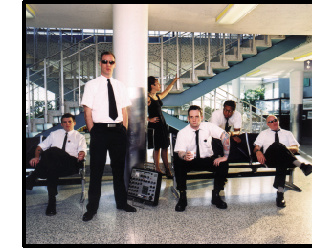

|

|

|

|
| |
|
|
|
Standards Who Stole the I Walkman?
Tortoise are the undisputed leaders of a new movement in modern music, dubbed "post-rock" by journalists and "math-rock" by fans and detractors alike (depending on how well they did in undergraduate calculus courses, I presume). Theoretically, post-rock is a reaction against all rock music that came before, a bold assault against three-chord anthems, heavy-metal guitar solos and lung-bursting vocal histrionics. Or more to the point: "No big hair!" But Tortoise have never claimed to be anything more than a rock band. To position them as post-anything is to flatly ignore the influence of a great many musicians who have clearly shaped their sound, from jazzbos John McLaughlin and Miles Davis to minimalist composers Steve Reich and Philip Glass. And if Tortoise's albums define a new school of musical thought, then it is an impossibly amorphous and fluid one, as no two Tortoise LPs sound alike. When Tortoise emerged from the Chicago scene's primordial soup in 1993, it was a
Shortly before recording their 1994 debut, Herndon and McCombs sought out musical assistance from local musicians John McEntire and Bundy Brown. McEntire's arrival marks a crucial juncture in the development of the band. Having studied computers and music technology in college, McEntire helped the group realize its "studio band" aspirations. With McEntire manning the boards, Tortoise's raw rhythms were transformed into something infinitely more complex: cavernous, dub-influenced layers of bass and drums that create alternating waves of tension and release, moving in tidal patterns across the listener's headphones. The 1996 LP Millions Now Living Will Never Die was a radical departure, in which the group fulfilled the promise of its name. "Djed," the album's epic opener, unfolds at a glacial pace, beginning with ripples of static, evolving into a massive wave of minimalist vibe melodies, and receding just as surely as it came, leaving traces of foamy static on its sonic shores. Having exhausted the slow-and-steady theory of composition, Tortoise took another radical turn on TNT, released in 1998. Jeff Parker, a Chicago jazz guitarist, joined the fold, and the band composed the majority of the album's material in the studio, using ProTools software to cut and paste improvised bits into a cohesive whole. The result, born of an arduous, year-long recording process, was an almost incomprehensibly dense record. Each sound and sonic detail had been manipulated, edited and tweaked to perfection. TNT's beauty is its infinite depth--unraveling over repeated listens, the album reveals secrets with every spin. But the endless vista that technology opened on TNT was also a perilous threat. Critics assailed it as too studied and too intellectual, robbing jazz of its spontaneous magic and reducing it to a rote musical exercise. On Standards, Tortoise's new LP, the group appears to have reinvented itself again. The irony of the album's title is obvious from its first notes on "Seneca," as Parker's distorted, warbling guitar feeds back with Hendrixian glee and Herndon bashes away at the traps with reckless abandon. It's a cacophonous racket that resolves itself with a sort of warped melodic logic, and the most furious bit of music Tortoise have ever recorded. Two minutes in, a complex Herndon beat locks the band in step and the trademark Tortoise guitar sound (warbly and thick, like an underwater bell tower striking high noon) appears, reassuring the listener that the band is still alive and kicking beneath all the bombast. There is uncharacteristic immediacy here, but it shouldn't be mistaken for sloppiness or spontaneity. As much as Standards expands Tortoise's sonic palette, it is ultimately a record of intricately woven compositions. Take "Benway," the third track on Standards. Beginning with a series of drum 'n' bass percussion clicks and the most prominent synthesizer line in Tortoise's canon, the track's brooding vibe suddenly resolves into a TNT-like bit of repetitive riffage. Vibes and guitar lock into a minimalist major key motif that turns itself around into a jazzy bit of discordant skronk. In less than five minutes, Tortoise successfully synthesize the last two decades of experimental and improvisational music; and it's not nearly as intellectual as that sounds. This is mind music that moves the booty as well. "Monica" marks Tortoise's return to confounding mode, as the group exchanges its underwater warble for something resembling French house music. As the disco ball drops and diamonds of light glimmer and spin, a vocoder gurgles over New Age synth swells. But once again, Tortoise seamlessly change directions, from disco to electro-jazz, with time left for brief excursions into trip-hop and horn-infected dub. Standards is a deceptive animal. Some listeners will hear the violent guitar stabs that open the album and declare that Tortoise have launched a punk-rock assault against their critics, but beneath the newly painted shell resides the same thoughtful, patient beast that reinvented rock music. While TNT was dense, diverse and mysterious, Standards is forceful and cohesive. Over the course of the album's 10 tracks, Tortoise merge disparate elements like flamenco guitar, hand claps, analog synth burbles and backward tape loops into a seamless, harmonious whole. For a more radical revision of post-rock's sound, listeners should tune into Isotope 217. Major players in Chicago's free-jazz, post-rock scene for the past four years, Isotope 217's revolving lineup has recently become almost identical to Tortoise itself. Herndon, Parker and (Tortoise percussionist) Dan Bitney are all members, and McEntire runs the boards, but the distinct presence of cornet player Rob Mazurek prevents the two bands from becoming sonic Siamese twins. Isotope's 1997 debut album, The Unstable Molecule, was a melting pot of electric Miles and U.K. downbeat trip-hop stylings. Cornet and trombone added a jazzy, speakeasy feel lacking on Tortoise's early work, and the group's occasional ventures into the realm of funk (check the Bootsy Collins-inspired bass work on "Phonometrics") further distinguished the group from its Chicago brethren. Their latest disc, Who Stole the I Walkman?, could hardly be further from their roots. With the departure of trombonist Sara P. Smith after Molecule, Isotope's horn-heavy sound has been slowly replaced by sound effects, samples and studio manipulation. Thanks in large part to Mazurek abandoning his cornet for his laptop, Isotope's sound has become more synthesized and alien, floating across Kubrickian space vistas like an extraterrestrial transmission. Where horns once swooped and swooned, unidentifiable radar blips cavort, and the jazzy rim shots and brushed snares of Molecule and 1999's Utonian Automatic have been replaced with percussive clicks and skittering drum 'n' bass patterns. Moreover, the compositional structure of previous efforts has been done away with altogether. Ideas stack upon one another as grooves appear and disappear with impish levity. "Meta Bass" mixes a traditional guitar and synth combo with a cumulus six-string attack, only to unexpectedly morph into a funky bass trance. "Moonlex" could be an alternate soundtrack to any one of a thousand different sci-fi docking sequences. Droning sub-frequencies, bleeping consoles, whirring machinery and oscillating hums conjure up crater-covered lunar landscapes. The album's space-age kitchen sink approach is often more distracting than interesting, however. Walkman seems to resist repetition at all costs, leaving the listener to dangle while the good grooves pass on by. One of the few tunes to sustain a musical idea for an extended period is "Moot Ang," which also happens to be the most fusion-inflected track. As a 12-note guitar figure plods deliberately along, tribal percussion and moody horns build to a fever pitch until exploding like an angry hive of cyborg bees. It's a beautiful moment of barely controlled chaos and an all-too-infrequent revelation. But even Walkman's most awkward stabs at innovation are
a welcome respite from the stagnant pop that rules the radio. Perhaps
this is why Isotope 217, Tortoise (and their labelmates in the Sea
and Cake, Brokeback and Trans Am) are perpetually set apart by music
critics. For all their sonic disparity, these groups share two crucial
features--the belief that rock 'n' roll remains a vital musical
form and the creativity to prove it.
|


